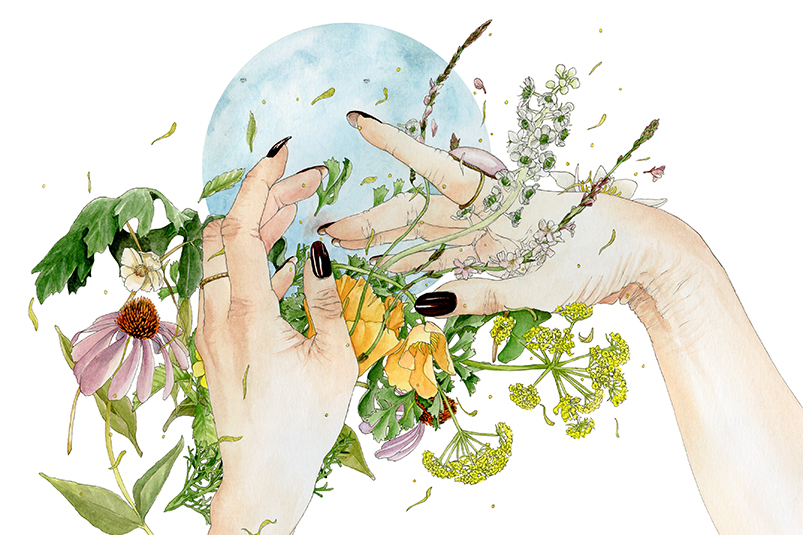Witchery in the Garden

Stir them in your witch’s brew: purple coneflower, bloodroot, vervain, American pokeweed, mayapple, parsley, California poppy and cinquefoil (clockwise from left, roughly). ILLUSTRATION Hallie Rose Taylor
“ARE YOU A WITCH?” asked the little girl from down the street who saw me working in my garden on one of the last days of autumn.
“Why do you ask? Would it frighten you if I were?” I said.
“You have long gray hair and you grow funny plants,” she said, not coming any closer.
I assured her that if I were indeed a witch, I would be a good witch, not an evil one. I took off my well-worn garden gloves, rested my rake and sat down on the low, red brick wall that hems in part of my herb garden.
The girl stood still.
“In the olden days many talented women knew how to grow all kinds of medicinal herbs and other plants that helped people in many ways. But some people accused the women of doing bad things with their plants and called them witches,” I said. “Would you like to hear about them?”
I told the little girl about several native plants that are closely associated with “witches” — American pokeweed (Phytolacca americana), cinquefoil (Potentilla spp.), various vervains (Glandularia or Verbena spp.) and nightshades (including Chamaesaracha, Circaea and Solanum spp.) — as well as non-natives belladonna, garden parsley, wolfsbane and smallage (wild celery); the last is said to have been used by witches to prevent cramps while flying.
According to Dorothy Jacob, author of “A Witch’s Guide to Gardening,” almost every plant on earth has been used in witchcraft except Angelica archangelica, another type of wild celery. In fact, all parts of wild angelica, which is also used as an antifungal and antibacterial herb, were used against witchcraft. In Europe, the plant was pulverized into a powder and sprinkled around a house to repel witches and their spells.
Long ago, I decided to grow a small “witch’s garden” because I find the plants fascinating and helpful. But I only grow safe witchery plants, not poisonous ones, because I don’t want to unintentionally hurt man or beast. I also told the little girl never to eat an unknown plant from the wild or someone’s garden. The little girl nodded in understanding, her honey-colored ponytail bouncing up and down.
I began my native witch’s garden with transplants from my mother’s rich woodland property in the Midwest, as well as from sunny fields belonging to friends near my Ohio home. I grow Solomon’s seal (Polygonatum biflorum), a native wildflower, which is said to provide protection from evil and can also be used to heal bruises and minor skin irritations. Purple coneflowers (Echinacea purpurea) are picked to sharpen skills and increase spells. The mayapple (Podophyllum peltatum) is thought of as an aphrodisiac (I described it as a “love potion” for the little girl). Bloodroot (Sanguinaria canadensis) is used for cleansing the soul. And witches suggested planting native trees, including white oak (Quercus alba), to guard against evil near a home.
I also told the girl about witchery plants I have never grown. The California poppy (Eschscholzia californica) can be used in magickal (rather than “magical” like a stage act in Las Vegas) spells for prosperity and better sleep; the evening primrose (Oenothera biennis), on the other hand, is said to facilitate shape-shifting.
I told my young visitor how some witch’s ingredients weren’t at all what they seemed to be. A “bat’s wing” was probably holly, named for the shape of its leaves. A witch’s brew really called for the plant, not part of a flying mammal. Today many people still like to grow holly because they believe it provides “protection and security.”
“Are the plants in your garden magic?” asked the little girl, her eyes finally meeting mine.
“Only in the sense that to me they are amazing. And that next spring I know many will greet me again, rising miraculously from being asleep in the earth,” I said. “I try to be good to my plants. Some people say you should give yourself and your witch’s garden some privacy by enclosing part of it with a vine-covered trellis or fence. Others say to sleep one night a year in your garden, letting the plants talk to you in your dreams. But I would miss my soft bed too much!”
“My mother would never let me do that,” the little girl said, frowning. “I better go.” She hesitated and added, “Are you sure you’re not a witch?”
“I don’t have any ‘eye of newt and toe of frog,’” I confessed in my best Shakespearean witch’s voice.
“OK, I’ll be back next spring,” she said, skipping out of my yard.
Jill Sell is a regular contributor to Wildflower magazine.

